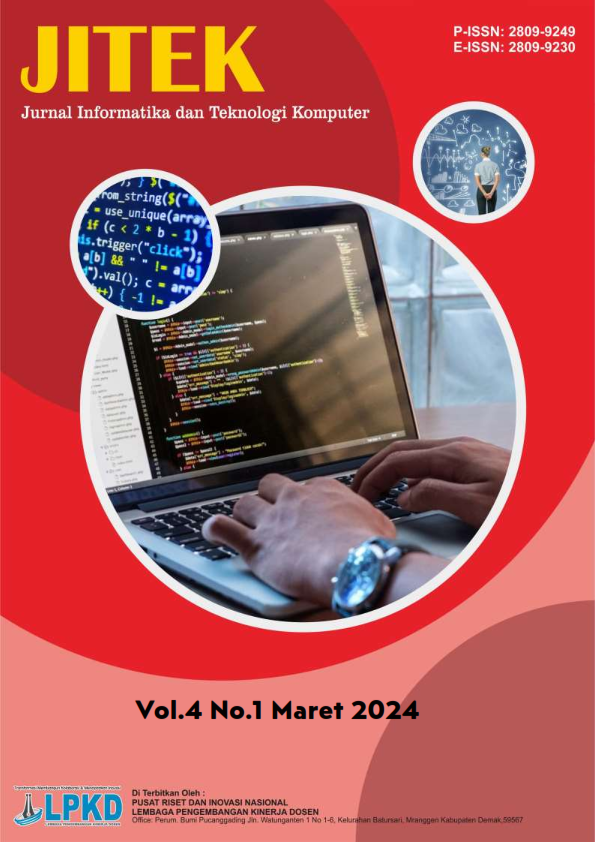Klasterisasi Lagu Populer dan Eksplorasi Subgenre Spotify 2024 dengan K-Medoids
DOI:
https://doi.org/10.55606/jitek.v5i1.5699Keywords:
K-Medoids, Spotify, genre, clustering, subgenreAbstract
Spotify's genre classification system remains too broad, often grouping songs with distinct characteristics into the same category. For example, Pop Ballads and Dance Pop are frequently classified under "Pop" despite significant differences in tempo, emotion, and production style. This leads to inaccurate song recommendations. This study applies the K-Medoids algorithm to enhance song classification based on Spotify Playlist Count, Spotify Playlist Reach, and Spotify Popularity. The CRISP- DM methodology guides business understanding, data understanding, data preparation, modeling, evaluation, and deployment. Clustering results without popularity ranking reveal three main groups: songs with low playlist count but high reach (dominated by light hip-hop), songs with high playlist count and reach (dominated by contemporary R&B), and songs with low popularity (dominated by dance). After ranking by popularity, clusters became more defined, with alternative pop dominating the high-reach cluster, contemporary R&B in the popular cluster, and dance pop in the less popular cluster. Evaluation using a Silhouette Score of 0.5014 indicates good cluster quality. Additionally, this study successfully identified the 15 most popular songs on Spotify in 2024. These findings can help Spotify refine its recommendation system by incorporating subgenre-based classification, ensuring more accurate search results aligned with user preferences and evolving music trends.
References
L. Suastri, “8_Clustering Pop Songs Based on Spotify Data Using K-Means.”
A. Werner, “Organizing music, organizing gender: algorithmic culture and Spotify recommendations,” Popular Communication, vol. 18, no. 1, pp. 78–90, Jan. 2020, doi: 10.1080/15405702.2020.1715980.
N. R. Fitradhi, M. Firman Hidayat, T. W. Saputro, M. G. Alifian, and A. P. Sari, “Laporan Final Project Machine Learning Rekomendasi Musik Spotify Menggunakan Metode K-Means,” 2023.
Algoritma K-Medoids untuk Pengelompokkan Sebaran Mahasiswa Baru Eka Irawan, S. Putra Siregar, I. Sudahri Damanik, I. Syaputra Saragih, P. Studi Sistem Informasi, and S. A. Tunas Bangsa Jl Jend Sudirman Blok no, “Implementasi K-Medoids untuk Pengelompokkan Sebaran Mahasiswa Baru (Eka Irawan) |275,” Jurnal Riset Sistem Informasi Dan Teknik Informatika (JURASIK), vol. 5, pp. 275– 281, [Online]. Available: https://tunasbangsa.ac.id/ejurnal/index.php/jurasik
G. Gandhi and R. Srivastava, “Analysis and Implementation of Modified K-Medoids Algorithm To Increase Scalability And Efficiency For Large Dataset.” [Online]. Available: http://www.ijret.org
M. Mufidah, A. Amirah, A. W. Widodo, and C. Dewi, “Pengelompokan Lagu Berdasarkan Emosi Menggunakan Algoritma Fuzzy C-Means,” 2017. [Online]. Available: http://j-ptiik.ub.ac.id
B. Anoohya1, J. Nikitha, N. Jyothi, I. Anish, and G. Bhargavi, “Recommendation system for song data using K-Means and K-Medoids Clustering algorithm,” 2023. [Online]. Available: www.ijnrd.org
A. R. Zaidah, C. I. Septiarani, S. Nisa, A. Yusuf, and N. Wahyudi, “Komparasi Algoritma K-Means, K-Medoid, Agglomeartive Clustering Terhadap Genre Spotify,” vol. 7, no. 1, 2021, [Online]. Available: https://ejournal.fikom-unasman.ac.id
C. Pangestu, S. Shaufiah, and R. Wijaya, “X Spotify Cares Clustering Analysis using K-Means and K-Medoids,” Jurnal Media Informatika Budidarma, vol. 8, no. 1, p. 497, Jan. 2024, doi: 10.30865/mib.v8i1.7279.
L. Ivania Sidora and N. Hanum Harani, “Sistem Rekomendasi Musik Spotify Menggunakan Knn Dan Algoritma Genetika,” 2023.
S. Marlia et al., “SISTEMASI: Jurnal Sistem Informasi Analisis Fitur Musik dan Tren Popularitas Lagu di Spotify menggunakan K-Means dan CRISP-DM Analysis of Music Features and Song Popularity Trends on Spotify Using K-Means and CRISP-DM.” [Online]. Available: http://sistemasi.ftik.unisi.ac.id
S. Kim, J. Park, K. Seong, N. Cho, J. Min, and H. Hong, “Music-Circles: Can Music Be Represented With Numbers?,” Feb. 2021, [Online]. Available: http://arxiv.org/abs/2102.13350
J. Mantik and N. Ayu Privandhani, “2022) 1542-1550 Accredited,” 2022.
N. Rohman and A. Wibowo, “Clustering Of Popular Spotify Songs In 2023 Using K-Means Method And Silhouette Coefficient,” Jurnal Pilar Nusa Mandiri, vol. 20, no. 1, pp. 18–24, Apr. 2024, doi: 10.33480/pilar.v20i1.4937.
K. Junaidi, A. C. Aurelie, S. Israwana, A. Putra, and A. Ryu, “Implementasi MapReduce Pada Dataset Spotify Top Music Untuk Mengetahui Artist yang paling banyak Didengar Dalam Kurun Waktu 10 Tahun,” vol. 2, no. 2, 2023, [Online]. Available: https://jurnal.netplg.com/
M. I. Firmansyah, R. S. Rohman, E. Marsusanti, U. Bina, S. Informatika, and D. D. Disetujui, “Penerapan Algoritma Klastering K-Means Untuk Fitur Atribut Pada Layanan Streaming Musik Spotify,” Journal Computer Science, vol. 2, no. 2, 2023.
A. R. Zaidah, C. I. Septiarani, S. Nisa, A. Yusuf, and N. Wahyudi, “Komparasi Algoritma K-Means, K-Medoid, Agglomeartive Clustering Terhadap Genre Spotify,” vol. 7, no. 1, 2021, [Online].
Available: https://ejournal.fikom-unasman.ac.id
C. Nisa and W. Yustanti, “Studi Perbandingan Algoritma Klastering Dalam Pengelompokan Persediaan Produk (Studi Kasus: Subdirektorat Perencanaan Sarana Prasarana Dan Logistik PTN X),” Journal of Emerging Information Systems and Business Intelligence (Jeisbi), vol. 02, no. 03, pp. 14– 20, 2021, [Online]. Available: https://ejournal.unesa.ac.id/index.php/JEISBI/article/view/41103%0Ahttps://ejournal.unesa.ac.id/in dex.php/JEISBI/article/download/41103/35454
A. Rohmah Zaidah, C. Indira Septiarani, M. Sholikhatun Nisa, A. Yusuf, and N. Wahyudi, “Komparasi Algoritma K-Means, K-Medoid, Agglomeartive Clustering Terhadap Genre Spotify,” Jurnal Ilmiah Ilmu Komputer, vol. 7, no. 1, pp. 49–54, 2021, doi: 10.35329/jiik.v7i1.186.
J. Ramadhani, Y. Safitra Anugraha, A. Fauzan, and L. Efrizoni, “Jilang Ramadhani 1 ,Yoga Safitra Anugraha 2,” 2024. [Online]. Available: http://ojsamik.amikmitragama.ac.id
B. Ardiansyah, I. Daulay, and R. Hutagaol, “SENTIMAS: Seminar Nasional Penelitian dan Pengabdian Masyarakat K-Means and Decision Tree Algorithm for Prediction of Postgraduate Students Admission in University of Indonesia Algoritma K-Means dan Decision Tree untuk Prediksi Penerimaan Calon Mahasiswa Pascasarjana pada Universitas Indonesia.” [Online]. Available: https://journal.irpi.or.id/index.php/sentimas
B. N. Sari, “Identification of Tuberculosis Patient Characteristics Using K-Means Clustering,”
Scientific Journal of Informatics, vol. 3, no. 2, pp. 129–138, Nov. 2016, doi: 10.15294/sji.v3i2.7909.
Downloads
Published
How to Cite
Issue
Section
License
Copyright (c) 2025 Jurnal Informatika Dan Tekonologi Komputer (JITEK)

This work is licensed under a Creative Commons Attribution-ShareAlike 4.0 International License.








